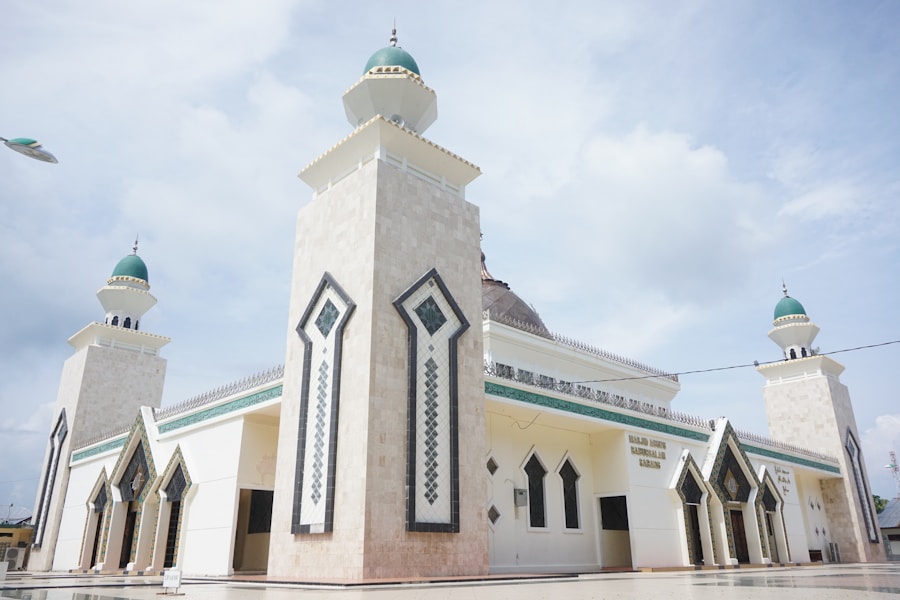Umrah, often referred to as the “lesser pilgrimage,” holds profound spiritual significance for Muslims around the world. Unlike Hajj, which is obligatory and has specific dates, Umrah can be performed at any time of the year. This flexibility allows millions of Muslims to engage in this sacred act of worship, which is believed to cleanse the soul and bring one closer to Allah.
The rituals of Umrah include Tawaf, the act of circling the Kaaba seven times, and Sa’i, walking between the hills of Safa and Marwah. Each of these acts is steeped in historical and spiritual meaning, tracing back to the actions of the Prophet Ibrahim (Abraham) and his family. The spiritual benefits of performing Umrah are manifold.
It is said to be a means of seeking forgiveness for past sins and a way to attain spiritual elevation. Many pilgrims report feelings of peace, fulfillment, and a renewed sense of purpose after completing their pilgrimage. The communal aspect of Umrah also fosters a sense of unity among Muslims, as they gather from diverse backgrounds to worship in one of the holiest places on Earth.
This shared experience can strengthen bonds within the global Muslim community, making Umrah not just a personal journey but a collective one.
Key Takeaways
- Umrah is a significant pilgrimage in Islam, often referred to as the “lesser pilgrimage” compared to Hajj.
- The best time to perform Umrah during the winter season is from December to February, when the weather is mild and comfortable for outdoor activities.
- The best time to perform Umrah during the summer season is from June to August, when the days are longer and provide more time for religious activities.
- Factors to consider when choosing the best time to perform Umrah include weather, crowd size, and personal schedule and preferences.
- The best time to perform Umrah during the spring season is from March to May, when the weather is pleasant and the landscape is blooming with greenery.
The best time to perform Umrah during the winter season
Winter is often considered one of the most favorable times to perform Umrah due to the milder weather conditions in Saudi Arabia. From December to February, temperatures in Mecca can range from 15°C to 25°C (59°F to 77°F), making it more comfortable for pilgrims who may find the heat overwhelming during other seasons. The cooler climate allows for longer hours of worship without the physical strain that high temperatures can impose.
This is particularly important for those who wish to engage in extended prayers and rituals, as they can do so without the discomfort of extreme heat. Moreover, winter months tend to see fewer crowds compared to the peak seasons of Hajj and Ramadan. This means that pilgrims can perform their rituals with greater ease and less congestion.
The experience of walking around the Kaaba or performing Sa’i can be significantly enhanced when there are fewer people around, allowing for a more intimate connection with the sacred space. Additionally, many hotels and travel agencies offer special packages during this season, making it more accessible for those looking to embark on their pilgrimage.
The best time to perform Umrah during the summer season

Summer in Saudi Arabia can be quite intense, with temperatures often soaring above 40°C (104°F). However, for those who are determined to perform Umrah during this season, there are specific times that can make the experience more manageable. The months of June through August are characterized by extreme heat, but early mornings or late evenings can provide a respite from the sweltering sun.
Pilgrims who choose to undertake their rituals during these cooler parts of the day can still enjoy a fulfilling experience while minimizing discomfort. Despite the challenges posed by the heat, summer also offers unique advantages for those performing Umrah. Many families take advantage of school holidays during this time, allowing them to travel together.
This can create a sense of togetherness and shared spiritual growth that enhances the pilgrimage experience. Additionally, summer months may see fewer international pilgrims compared to Ramadan or Hajj season, which can lead to shorter wait times at key sites like the Kaaba or during rituals such as Tawaf.
Factors to consider when choosing the best time to perform Umrah
When deciding on the best time to perform Umrah, several factors come into play that can significantly influence the overall experience. One primary consideration is weather conditions. As previously mentioned, Saudi Arabia’s climate varies greatly throughout the year, with summer presenting challenges due to extreme heat while winter offers a more temperate environment.
Pilgrims should assess their own tolerance for heat and cold when planning their journey. Another important factor is crowd levels. The timing of Umrah can greatly affect how crowded Mecca will be during one’s visit.
Peak seasons such as Ramadan and Hajj attract millions of pilgrims, leading to long lines and crowded spaces. Conversely, off-peak times may provide a more serene atmosphere conducive to reflection and prayer. Additionally, personal circumstances such as work commitments, family obligations, and financial considerations should also be taken into account when selecting a time for pilgrimage.
The best time to perform Umrah during the spring season
Spring is another excellent time for performing Umrah, particularly from March to May when temperatures begin to rise but remain relatively mild compared to summer months. During this period, temperatures typically range from 20°C to 35°C (68°F to 95°F), making it comfortable for pilgrims who wish to engage in extensive worship activities without succumbing to extreme heat. The pleasant weather allows for longer hours spent in prayer and reflection at holy sites.
Additionally, spring often sees fewer crowds than both Ramadan and Hajj seasons, providing an opportunity for a more personal pilgrimage experience. Pilgrims can navigate through sacred sites with greater ease and engage more deeply in their spiritual practices without feeling rushed or overwhelmed by large groups. The blooming flowers and greenery in surrounding areas also add a sense of beauty and tranquility that enhances the overall experience.
The best time to perform Umrah during the fall season

Fall is another favorable season for performing Umrah, particularly from September to November when temperatures begin to cool down after the scorching summer months. During this time, temperatures typically range from 25°C to 35°C (77°F to 95°F), making it comfortable for pilgrims who wish to engage in outdoor rituals such as Tawaf and Sa’i without excessive heat stress. The gradual transition into cooler weather creates an inviting atmosphere for worshippers seeking spiritual rejuvenation.
Moreover, fall often sees a decrease in crowd levels compared to peak pilgrimage seasons. This allows for a more intimate experience at holy sites where pilgrims can connect with their faith on a deeper level. The reduced number of visitors also means shorter wait times for essential rituals, enabling pilgrims to focus on their spiritual journey rather than logistical challenges.
Additionally, many travel agencies offer attractive packages during this season, making it an appealing option for those looking to embark on their pilgrimage.
Tips for making the most of your Umrah experience during different seasons
Regardless of when one chooses to perform Umrah, there are several tips that can enhance the overall experience across different seasons. First and foremost, staying hydrated is crucial, especially during hotter months.
This is particularly important during summer when dehydration can quickly become a concern. Another valuable tip is to plan your itinerary wisely based on crowd levels and weather conditions. For instance, scheduling visits to key sites early in the morning or later in the evening can help avoid peak crowds and extreme temperatures.
Additionally, engaging with local guides or joining organized groups can provide insights into lesser-known aspects of Mecca’s history and culture, enriching the pilgrimage experience. Lastly, maintaining an open heart and mind is essential throughout the journey. Each season offers unique opportunities for reflection and connection with one’s faith.
Embracing the challenges that come with different weather conditions or crowd levels can lead to personal growth and deeper spiritual insights.
Finding the perfect time for your Umrah pilgrimage
Choosing the right time for your Umrah pilgrimage is a deeply personal decision influenced by various factors including weather conditions, crowd levels, personal circumstances, and spiritual goals. Each season presents its own unique advantages and challenges that can shape your experience in profound ways. Whether you opt for the cooler months of winter or spring or decide to brave the heat of summer or fall, what remains constant is the opportunity for spiritual renewal and connection with Allah.
Ultimately, it is essential to approach this sacred journey with intention and mindfulness. By considering all aspects—from climate and crowd dynamics to personal readiness—you can find a time that resonates with your spiritual aspirations and logistical needs. Regardless of when you choose to embark on this pilgrimage, what matters most is your commitment to engaging fully in the rituals and experiences that make Umrah a transformative journey in your life as a Muslim.
If you are looking for a magical getaway after performing Umrah, consider visiting the majestic Castle on the Cliff in Manoir. This enchanting destination offers a unique and luxurious experience that will leave you feeling rejuvenated and inspired. To learn more about this hidden gem, check out this article detailing the beauty and charm of the Castle on the Cliff.
FAQs
What is Umrah?
Umrah is a pilgrimage to Mecca, Saudi Arabia, performed by Muslims that can be undertaken at any time of the year. It is not mandatory, but highly recommended in Islam.
When is the best time to perform Umrah?
The best time to perform Umrah is during the month of Ramadan, as the rewards for performing Umrah during this time are believed to be greater. However, Umrah can be performed at any time of the year except during the Hajj season.
Can Umrah be performed during the Hajj season?
Umrah cannot be performed during the Hajj season, which takes place in the Islamic month of Dhu al-Hijjah. This is because the focus during this time is on the Hajj pilgrimage, which is one of the Five Pillars of Islam.
Are there any specific times of the year when Umrah is discouraged?
Umrah is not specifically discouraged at any time of the year, but it is important to consider factors such as weather, personal circumstances, and the influx of pilgrims in Mecca when planning the pilgrimage.
What are the peak seasons for Umrah?
The peak seasons for Umrah are during the month of Ramadan and the Islamic month of Shawwal, which follows Ramadan. These times see a higher number of pilgrims and may result in increased costs for travel and accommodation.



0 Comment